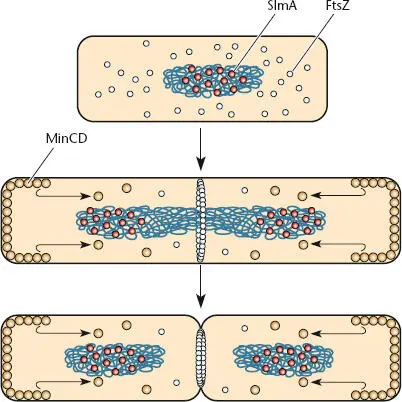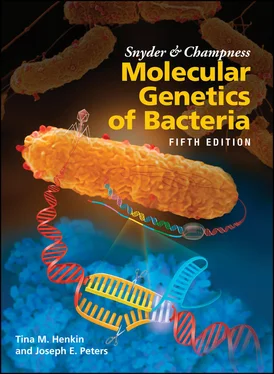Regulation of septum formation in B. subtilis differs from that found in E. coli . In B. subtilis , MinE is lacking and MinC and MinD do not oscillate. Instead, MinCD appears to tether directly to the cell poles by binding to another protein at the cell poles, called DivIVA. This binding creates a gradient of concentration of MinCD in the cell and similarly only allows formation of a single FtsZ ring at the center of the cell. Therefore, these two model bacteria use somewhat different mechanisms to establish a gradient of MinCD concentration and thereby restrict FtsZ ring formation to the center of the cell ( Figure 1.22).
Not only should the FtsZ ring form only in the center of the cell, it also should not initiate the assembly of a division septum while the nucleoid is still occupying the center of the cell, or it might constrict the membrane around the chromosome. In fact, it was observed in E. coli that FtsZ rings never formed in the center of the cell when it was still occupied by the nucleoid, which had not yet segregated. Proteins that inhibit FtsZ ring formation in the presence of the nucleoid were discovered in both E. coli and B. subtilis at about the same time and were named nucleoid occlusion proteins. Both proteins were found because they are essential only if the Min system is inactivated. There is evidence that another process drives formation of the FtsZ at the midcell and that having both Min and nucleoid occlusion systems serves to increase the accuracy of the division process. The nucleoid exclusion protein in B. subtilis , named Noc, was found serendipitously, because its gene, noc , is adjacent to the genes for the Par functions, soj and spo0J , and it was observed that mutations in this gene could not be combined with mutations in the minD gene without making the cells very sick. The reason noc mutant strains were sick was that they were forming long filaments of cells because they were not dividing properly. The nucleoid occlusion protein in E. coli , named SlmA, was found directly by a synthetic lethal screen (see Bernhardt and de Boer, Suggested Reading). A synthetic lethal screen is a powerful genetic tool in which mutations in genes whose products are required only if another gene product is absent are isolated. The investigators looked for mutations in genes that were required only in the absence of the products of the min genes. They expressed the min genes from an inducible promoter and looked for mutants that were sick and failed to form colonies only in the absence of inducer. Some of these mutants had mutations in a gene that was named slmA by the investigators. While mutants deficient in Min proteins had more Z rings, they were never over the nucleoids ( Figure 1.22). However, mutants that lacked both the Min proteins and SlmA often formed FtsZ rings over the nucleoids, as expected for a mutant deficient in nucleoid occlusion. The use of inducible promoters and other examples of synthetic phenotypes are discussed in more detail in later chapters.

Figure 1.22 The MinCDE and nucleoid occlusion systems control placement of the FtsZ ring in E. coli . The FtsZ ring is an important marker of the central division site in a soon-to-divide cell which should not assemble until the chromosome is ready to segregate. MinC, which interacts with MinD, prevents a FtsZ ring from forming anywhere but at the center of the cell. Different mechanisms are used in bacteria to limit the concentration of MinCD at the center of the cell, as described in the text, to prevent FtsZ ring formation outside the center of the elongating cell. The nucleoid occlusion protein of E. coli , SlmA, is an important system that ensures that the FtsZ ring does not form over the nucleoid until the chromosomes are nearly completely replicated and segregated into daughter cells. Because the SlmA-binding sites are absent from the terminus region, the FtsZ ring can start to form once chromosomal replication is nearly complete and the origin region has progressed into the daughter cells away from the division site. See the text for details.
The Noc and SlmA proteins seem to act by binding to DNA and then inhibiting FtsZ ring formation close to the DNA to which they are bound. There are known to be DNA sequences called Noc-binding sites (NBS) that are bound by Noc, and SlmA-binding sites (SBS) that are bound by SlmA; these sites are distributed across the chromosome and concentrated in the origin region but are absent from the terminus region ( Box 1.1). This allows SlmA and Noc to help protect the nucleoid from the division septum until the final moments prior to the completion of DNA replication (see Wu et al., Suggested Reading) ( Figure 1.22).
Note that this entire section has focused on simple division in rod-shaped cells. Fascinating adaptations to these simple ideas are known to occur in systems where the cells resulting from division are morphologically distinct. A particularly well-studied system in Caulobacter crescentus shows many adaptations when a mother cell gives rise to smaller motile daughter cells. Additionally, round or coccoid cells have distinct mechanisms that allow them to divide with clear cell poles as are found in rod-shaped cells. Given the extreme morphological variation known to occur across bacteria (see Kysela et al., Suggested Reading), interesting adaptations for division likely await discovery.
Coordination of Cell Division with Replication of the Chromosome
It is not sufficient to know how chromosomes replicate and then segregate into the daughter cells prior to division. Something must coordinate the replication of the chromosome with division of the cells. If the cells divided before the replication of the chromosome was completed, there would not be two complete chromosomes to segregate into the daughter cells, and one cell would end up without a complete chromosome. The mechanism by which cell division is coordinated with replication of the DNA is still not completely understood, but there is a lot of relevant information.
TIMING OF REPLICATION IN THE CELL CYCLE
It is important to know when replication occurs during the cell cycle. Experiments were designed to determine the relationship between the time of chromosome replication and the cell cycle in E. coli (see Helmstetter and Cooper, Suggested Reading). The conclusions are still generally accepted, so it is worth going over them in some detail. The investigators recognized that if the DNA content of cells at different stages in the cell cycle could be measured, it would be possible to determine how far chromosome replication had proceeded at that time in the cell cycle. Since bacterial cells are too small to allow measurements of DNA content in a single cell by the methods they had, it was necessary to measure the DNA content in a large number of pooled cells. However, cells growing in culture are all at different stages in their cell cycles. Therefore, to know how far replication had proceeded at a certain stage in the cell cycle, it was necessary to synchronize the cells in the population so that all were the same age or at the same point in their life cycles at the same time.
Helmstetter and Cooper accomplished this by using what they called a bacterial “baby machine.” Their idea was to first label the DNA of a growing culture of bacterial cells by adding radioactively labeled nucleosides and then fix the bacterial cells on a membrane. When the cells on the filter divided, one of the two daughter cells would no longer be attached and would be released into the medium. All of the daughter cells released at a given time would be newborns and so would be the same age. This means that cells that divided to release the daughter cells at a given time would also be the same age and would have DNA in the same replication state. The amount of radioactivity in the released cells was then a measure of how much of the chromosome had replicated in cells of that age. This experiment was done under different growth conditions to show how the timing of replication and the timing of cell division are coordinated under different growth conditions.
Читать дальше












